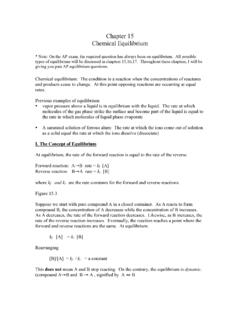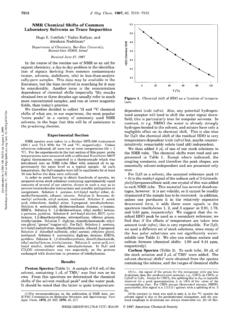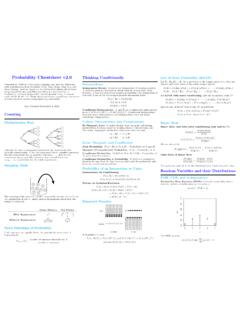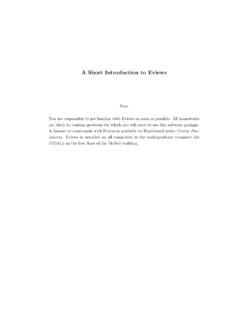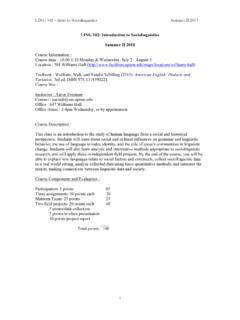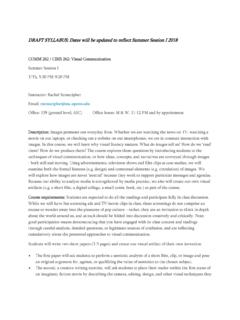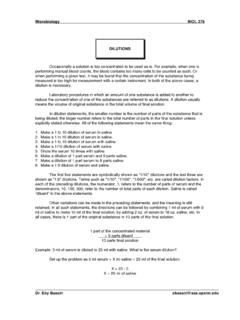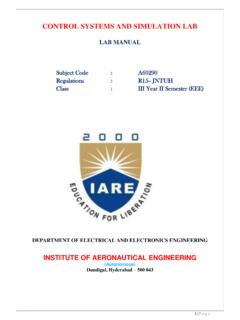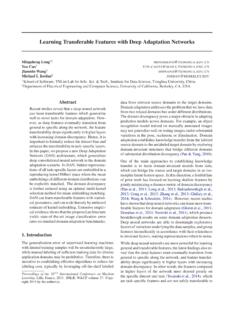Transcription of BACTERIAL GROWTH CURVE I. OBJECTIVES II. INTRODUCTION
1 Microbiology BIOL 275 Dr. Eby Bassiri 1 BACTERIAL GROWTH CURVE I. OBJECTIVES To determine the GROWTH rate of bacteria under different temperature and aeration conditions To establish GROWTH curves for an unknown BACTERIAL species and observe the different phases of GROWTH To demonstrate skill and knowledge in the use of the spectrophotometer. II. INTRODUCTION Bacteria normally reproduce by binary fission, forming two equal-sized progeny cells and thus doubling their number with each division.
2 This type of cell division is called exponential; , one cell divides to form two, each of these cells divides so that four cells are obtained, and so forth in a geometric progression. The unit of microbial GROWTH is "generation time", which is the time required to achieve a doubling of the population size and is designated as tgen. Generation time can be estimated by determining cell numbers during the period of active cell division and is expressed mathematically as: tgen=tln2lnXt lnX0=tlog2logXt logX0 In the above equations, t is the elapsed time during which GROWTH is measured, and Xo and Xt are the number of bacteria at times zero and t, respectively.
3 The presence of 2 in the numerator of the equations is due to the fact that when doubling of the population number occurs, the quantity Xt/Xo (called the doubling constant) will be equal to 2. Note that ln 2 = and log 2 = Also note that log 10n = n. So it is easier to use the log form rather than the ln form of the equation. The generation time of many bacteria is usually several hours. However, under optimum conditions, E. coli has a generation time of about 20 minutes. Thus it can be calculated that a single E.
4 Coli cell will produce about a thousand progeny in hours and over a million in hours. If the generation time and the elapsed time are known, then the number of generations can be estimated as follows: Number of generations = t/ tgen Microbiology BIOL 275 Dr. Eby Bassiri 2 Since the optical density of the culture is proportional to the cell density, measuring the turbidity of the culture solution can be used in estimating numbers of BACTERIAL cells, if a GROWTH CURVE for the conditions used has already been established.
5 This is the most common method used to rapidly estimate BACTERIAL numbers. Other methods, such as viable plate counts, can also be used for determining BACTERIAL GROWTH curves but are often more tedious than turbidity measurements. A BACTERIAL population follows a characteristic GROWTH CURVE which has four phases: the lag phase, the log or exponential GROWTH phase, the stationary phase, and the death phase. 1. Lag phase: During this phase, there is no increase in cell number; rather, bacteria are preparing for reproduction and synthesizing DNA and various inducible enzymes needed for cell division.
6 2. Log phase: This phase, also called the exponential phase, follows the lag phase and starts with a rapid increase in BACTERIAL number. At this stage, the logarithm of BACTERIAL biomass increases linearly with time so that numbers of BACTERIAL cells in a given interval of time is proportional to the biomass of bacteria present. 3. Stationary phase: The number of bacteria reaches a maximum in this phase and does not increase further (the GROWTH rate is exactly equal to the death rate). This phase is sometimes called the plateau stage.
7 A BACTERIAL population may reach stationary GROWTH when a required nutrient is exhausted, when inhibitory end products accumulate, or when physical conditions are inappropriate for GROWTH . The duration of the stationary phase varies, with some bacteria exhibiting very long stationary phases. 4. Death phase: Eventually, the number of viable BACTERIAL cells begins to decline, signaling the onset of the death phase. No further divisions occur in this phase. Death rate, in many cases, follows the same kinetics as the exponential GROWTH .
8 Microbiology BIOL 275 Dr. Eby Bassiri 3 In this laboratory exercise, you will work in groups and follow the normal GROWTH CURVE of an unknown BACTERIAL species to determine its generation time at different temperature and aeration conditions. Turbidity, which is a measure of the GROWTH of microorganisms, is determined via an instrument called a spectrophotometer. The basis for the use of this instrument is that less light passes through a turbid solution than through a clear solution; , the more turbid a solution (more GROWTH ), the less the amount of light transmitted through the solution.
9 Inside a spectrophotometer, light is focused through a lens system to an entrance slit. The light rays are refocused by a second lens to an exit slit. Between the second lens and the exit slit is a monochromatic grating which separates the white light into its component wavelengths in much the same way as a prism does. By proper rotation of the monochromatic grating, specific light wavelengths may be passed on through the exit slit to a photocell. This cell is connected directly to a galvanometer that translates the electrical output of the activated photocell into a specific transmittance value.
10 In between the exit slit and the photocell is a chamber where samples may be placed. As previously mentioned, a clear specimen will yield 100% transmittance, while a turbid sample will deflect a considerable portion of the light rays, resulting in a lower percent transmittance. The greater the density, the lower the percent transmittance. The sample is placed in a special test tube called a "cuvette", which fits the spectrophotometer snugly. Cuvettes are very expensive and care should be exercised in handling them.
